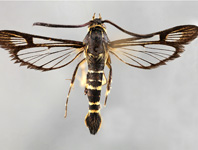Abstract
The nymph of Tramea binotata (Rambur, 1842) is described and illustrated based on reared specimens from Brazil and Ecuador, and also matching nymphs from Venezuela. A new character was discovered, i.e., density of minute spiniform setae scattered on the dorsum of abdominal segments 7 & 8, that separates the Neotropical species into two groups: high density of the tiny setae separates T. binotata, T. insularis Hagen, 1861 and T. calverti Muttkowski, 1910 from the other known species which have zero to only a few of these setae. Tramea binotata is distinct from most other Neotropical species known in the nymph stage by having only 7 or 8 palpal setae, rarely 6 or 9, on one side (versus 10–12); T. calverti and T. insularis have similar low numbers of palpal setae (8–10) but each has more premental setae per side (11–14 in calverti and insularis vs. 8–10, rarely 11, in binotata). The nymphs of Tramea minuta De Marmels & Rácenis, 1982 and T. rustica De Marmels & Rácenis, 1982 are still unknown.
References
Belle, J. (1988) A record of the Old World species Tramea basilaris burmeisteri Kirby from the Suriname (Odonata: Libellulidae). Zoologische Mededelingen, 62, 1–3.
Byers, C.F. (1927) Notes on some North American dragonfly nymphs (Odonata, Anisoptera). Journal of the New York Entomological Society, 35, 65–74.
Calvert, P.P. (1928) Report on Odonata, including notes on some internal organs of the larvae. University of Iowa Studies, 12 (2), 1–44.
Corbet, P.S. (1953) A terminology for the labium of larval Odonata. The Entomologist, 86, 191–196.
Corbet, P.S. (1999) Dragonflies. Behavior and ecology of Odonata. Comstock Publishing Associates, Cornell University Press, Ithaca, New York, 829 pp.
De Marmels, J. & Rácenis, J. (1982) An analysis of the cophysa-group of Tramea Hagen, with descriptions of two new species (Anisoptera: Libellulidae). Odonatologica, 11 (2), 109–128.
Dumont, H.J. (1977) On migrations of Hemianax ephippiger (Burmeister) and Tramea basilaris (P. de Beauvois) in west and north-west Africa in the winter of 1975/1976 (Anisoptera: Aeshnidae, Libellulidae). Odonatologica, 6 (1), 13–17.
Gambles, R.M. (1960) Seasonal distribution and longevity in Nigerian dragonflies. Journal of the West African Science Association, 6, 18–26.
Garrison, R.W., von Ellenrieder, N. & Louton, J.A. (2006) Dragonfly Genera of the New World. An Illustrated and Annotated Key to the Anisoptera. The Johns Hopkins University Press, Baltimore, MD, 368 pp.
Geijskes, D.C. (1934) Notes on the Odonata fauna of the Dutch West Indian Islands Aruba, Curacao and Bonnaire with an account on their nymphs. Internationale Revue der Gesamten Hydrobiologie und Hydrographie, 31, 284–311.
https://doi.org/10.1002/iroh.19340310116Klots, E.B. (1932) Insects of Porto Rico and the Virgin Islands, Odonata or dragonflies. New York Academy of Sciences 14, New York, 107 pp.
Landwer, B.H.P. & Sites, R.W. (2006) Diagnostic efficacy of morphological characters of larval Tramea lacerata Hagen and Tramea onusta Hagen (Odonata: Libellulidae) in the prairie region of Missouri. The Great Lakes Entomologist, 38 (3, 4), 155–163.
Landwer, B.H.P. & Sites, R.W. (2010) The larval Odonata of ponds in the prairie region of Missouri. Transactions of the American Entomological Society, 136 (1, 2), 1–105.
https://doi.org/10.3157/061.136.0201Meurgey, F. (2013) A catalogue of the West Indian dragonflies (Insecta: Odonata). Annales de la Société entomologique de France, New Series, 49 (9), 298–334.
https://doi.org/10.1080/00379271.2013.848066Meurgey, F. & Picard, L. (2011) Les libellules des Antilles françaises. Biotope éditions, Collection Parthénope, Mèze, 440 pp.
Needham, J.G., Westfall, M.J. Jr. & May, M.L. (2014) Dragonflies of North America. 3rd ed. Scientific Publishers, Gainesville, Florida, 657 pp.
Paulson, D.R. (2017) Middle American Odonata. Slater Museum of Natural History, University of Puget Sound. Available from https://www.pugetsound.edu/academics/academic-resources/slater-museum/biodiversity-resources/dragonflies/middle-american-odonata/ (accessed 21 March 2017)
Pinhey, E. (1962) Notes on African Odonata nymphs – 3. Journal of the Entomological Society of Southern Africa, 25, 230–235.
Santos, N.D. (1968) Contribuição ao conhecimento da fauna do estado da Guanabara. 66 – Descrição da ninfa de Trapezostigma cophysa (Selys, 1857) Cowley, 1934 e notas sobre a emergencia (Odonata, Libellulidae). Atas da Sociedade de Biologia do Rio de Janeiro, 12 (3), 169–171.
Schorr, M. & Paulson, D. (2017) World Odonata List. Slater Museum of Natural History, University of Puget Sound. Available from: https://www.pugetsound.edu/academics/academic-resources/slater-museum/biodiversity-resources/dragonflies/world-odonata-list2/ (accessed 8 March 2017)
Souza, L.O.I., Costa, J.M. & Santos, T.C. (1999) Redescrição da larva de Tramea calverti Muttkowski, 1910, com chave para identificação do gênero (Odonata, Libellulidae). Boletim do Museu Nacional, Rio de Janeiro, New Series, 409, 1–7.
Suhling, F. & Müller, O. (2014) The dragonfly larvae of Namibia (Odonata). Libellula Supplement, 13, 5–106.
Walker, E.M. & Corbet, P.S. (1975) The Odonata of Canada and Alaska, Vol. 3. University of Toronto Press, Toronto, 307 pp.
https://doi.org/10.3138/9781442654204Watson, M.C. (1956) The utilization of mandibular armature in taxonomic studies of anisopterous nymphs. Transactions of the American Entomological Society, 81, 155–202.

